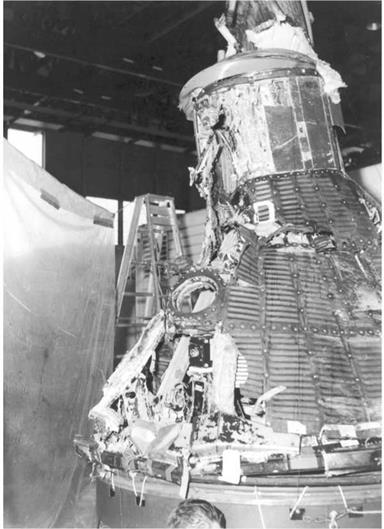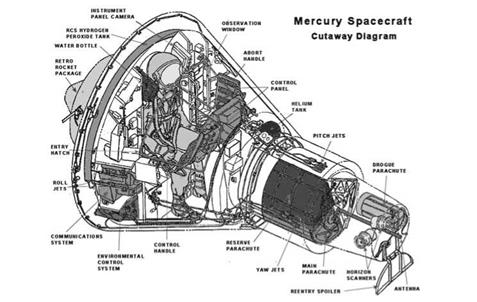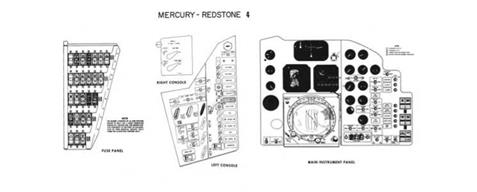MERCURY SPACECRAFT NO. 2
Meanwhile, following completion of the Capsule Systems Test (CST) at St. Louis, Spacecraft No. 2 was shipped to Huntsville, Alabama where it was test-mated with the booster allocated to the MR-1 mission to ensure complete compatibility between the two. After these checks the spacecraft was airlifted to the Cape, being delivered to Hangar S on 24 July. Here it would be installed within a room-sized, protective air – filtered plastic tent. This temporary facility was nowhere near the standard of the McDonnell ‘clean room,’ but it went a long way towards keeping the dust and other unwanted elements at bay.
As McDonnell design engineer Jerry Roberts explains, there was essentially unlimited access to the spacecraft at this stage, which allowed a little surreptitious activity for those seeking space-flown souvenirs.
“We had access to the spacecraft all the time in Hangar S. On nights when we worked the night shift we would take advantage of this access to curl up and fold dollar bills that everyone including some astronauts had signed into the spacecraft’s
|
With the seven Mercury astronauts watching from a bunker, an Atlas D launched into rain-soaked skies carrying the first production model of the Mercury capsule for the planned suborbital MA-1 flight. However, the Atlas exploded and disintegrated 58 seconds after liftoff. The jettisoned capsule hit the sea and was recovered, albeit extensively damaged. (Photo: NASA) |
cabling, and then we’d lace the cabling back up and tape it all up out of sight. It was a pretty big deal to put something in the spacecraft and have it flown in space. The idea was for the bills to fly in space and then we would recover them when we checked out the spacecraft after the flight. Sometimes this happened, but other times we didn’t get access to the spacecraft after the flight, and so to my knowledge those bills are probably still in those spacecraft wherever they are located today.”33
Early September 1960 would prove to be a time for greater optimism in the Mercury program. The testing of Spacecraft No. 2 in the Cape’s Hangar S was progressing well, and Spacecraft No. 6 had been delivered. It would be flown in February the following year on the first “bellyband” Atlas (67D) flight, as another unmanned test launch and recovery operation designated MA-2.
|
The badly damaged MA-1 capsule. (Photo: NASA) |
The Hangar S work schedule included the installation of parachutes and pyrotechnics, following which the fully equipped Spacecraft No. 2 was transported to the pad on 26 September. The Redstone booster had arrived earlier, been erected, and was now enclosed in the gantry (or service structure) which – as for all of the Redstone launch complexes – was basically a converted oil well rig. From the time of mating with the booster through to the scheduled launch date of 7 November, everything seemed to progress smoothly and few problems were encountered.
That month, the general training of the seven astronauts also narrowed and became far more concentrated on flying the first Mercury-Redstone missions.
|
A cutaway diagram of the Mercury spacecraft. (Photo: NASA) |
|
The MR-4 instrument panel. (Photo: NASA) |
The MR-1 launch did not proceed on 7 November as planned, because the helium pressure in the spacecraft’s control system dropped below the acceptable level. “A leak in the system, unfortunately under the heat shield, was obvious, and as a result the launch was scrubbed,” Luetjen explained. “The spacecraft was removed from the booster and the heat shield dropped to expose the culprit, a leaky relief valve.”34 The faulty valve was replaced, along with a hydrogen peroxide tank, and a minor wiring change was also made in response to an earlier test at Wallops Island. The following day, as the spacecraft was undergoing repairs, John Fitzgerald Kennedy was elected as the 35th President of the United States.
The MR-1 launch was rescheduled for 21 November and the countdown went well, apart from a short hold in order to fix a small leak in the hydrogen peroxide system. Ignition occurred at 9:00 a. m. and a mighty roar ripped across the Cape – but only momentarily. It was replaced by a sudden and unexpected silence. From behind his console in the blockhouse, Luetjen could only wonder what had gone wrong.
“Watching from the windows of the blockhouse, John Glenn and the Mercury dignitaries saw the booster wobble slightly on its pedestal and settle back on its fins after an inch or so rise. The booster engine shut down and the escape tower zipped up nearly a mile high and landed some 400 yards from the launch site. Three seconds after the escape rocket blew, the drogue package shot upward, followed in succession by the main and reserve parachutes, all of which fluttered down alongside the booster.
“After John Glenn witnessed the tower take off, he came running back to my console and said, ‘My God, Luge, the tower went!’ I had no appropriate answer, nor was John really expecting one. He was simply frustrated, as we all were.”35
Two days later Robert Gilruth issued a memorandum addressed to all Mercury personnel.
“Today I received the following TWX [teletype writer exchange] from the NASA Administrator: ‘As disappointed as I am in the results of yesterday’s shot, I know how discouraging these troubles are to you and your fine staff. Please try to close your ears to the press comments and know that there is no lack of faith in your ability to succeed in this effort. Now is the time for real driving leadership so grit your teeth and dig in. We are solidly behind you and your outfit. Signed, T. Keith Glennan, Administrator.’ “I should like to express to the NASA and MAC staff my wholehearted agreement with the above sentiment, and my pleasure at the very fine and unstinting effort I have observed in the work here. I have every confidence that the program is sound. The recent occurrence in the MR launch attempt merely emphasizes the importance of the early flight test program in uncovering these problems which can be identified only by bringing together all the various elements of the flight system in a real exercise. [Signed] Robert R. Gilruth, Director of Project Mercury.”36
The rocket was defueled and the remaining pyrotechnics carefully disarmed, but the fins had been damaged during the launch fiasco and the entire Redstone had to be replaced by another. Engineers tracked down the cause of the problem; they found a ‘sneak circuit’ in the booster ground cabling that caused an erroneous cutoff signal. Fortunately Spacecraft No. 2 was found to have come through the incident relatively undamaged and could be easily recycled. Within a week, plans were well under way for a replacement MR-1A mission using a substituted Redstone booster (MRLV-3), originally slated for the MR-3 mission. The spacecraft was fitted with the escape tower from Spacecraft No. 8 and the antenna fairing from Spacecraft No. 10.
Once the MR-1A spacecraft had been worked over at Hangar S and three verification tests completed, it was mated with the Redstone booster at Pad 5 on 9 December, with the launch set for ten days later. On the morning of 19 December, with all seven Mercury astronauts anxiously looking on, there was a 40-minute delay in the countdown caused by strong winds. And then a hydrogen peroxide solenoid valve had to be replaced, necessitating a 1-hour recycle of the countdown. Finally, at 11:15 a. m., liftoff occurred.
“This time there were no glitches,” Luetjen recalled. The 83-foot Mercury-Redstone assembly was cheered on… as it lifted off and burned brightly for 143 seconds before normal cutoff.”37
The mission was totally successful, with the Mercury spacecraft reaching an altitude of 130 miles and a range of 235 miles. The Redstone reached a slightly higher velocity than expected of 4,909 miles per hour, but this had no great impact on the overall mission. Spacecraft No. 2 was recovered from the Atlantic Ocean by recovery helicopters. “The spacecraft performed perfectly and the mission was a complete success,” Luetjen said in summing up the flight. “Exuberance reigned supreme!”38
The MR-1A test flight had now verified the operation of the Mercury system in the space environment. At a news conference held early in 1961, Robert Gilruth praised the efforts that had gone into the creation of the Mercury spacecraft.
“In October of 1958 the Mercury vehicle was only a concept,” he reported. “In two years this concept has been translated into facilities, trained teams, and flight hardware, and it is now, in two-plus years, in the initial phases of production test flights.
“This was an unusual and complex task. It required an integration of missile technology with the manned flight requirements. It involved an unprecedented cooperative effort between the military and civilians, and with foreign countries.
“It involved the building of a new technical know-how; that is, manned vehicle design and flight test methods, aeronautical unknowns, worldwide tracking and communications, and the development of industrial production and operational capability.”39
Most importantly of all, it had involved the tremendous work and dedication of Robert Gilruth.














